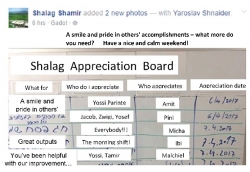Several people have contacted me recently for consultation on how to cope with the dilemmas they have encountered. In at least two cases, the decision would be very significant for the decision-maker.
Personal dilemma: make your own decision
Let's look first at a personal dilemma and later we will consider an organizational or company dilemma.
When the dilemma is personal, I recommend making your own decision in all cases. Remember that everyone, including those close to you, has personal agendas and interests in your decision. However objective the person you choose to advise you may be, they will be influenced by their own attitudes and perceptions of the matter. When the decision is an organizational one, the situation is different, and I'll expand on this later.
Costs and Benefits
When you are considering two or more options, make a list of costs and benefits for each one.
For example, if you are deliberating whether to leave your present job or not, there are two options – yes or no.
If you are deliberating whether to leave for another job, again, you have two options – the current job or the new one.
But if you are deliberating, for instance, what study program you should choose in university, it's quite likely you'll have many more options to consider.
For each option, list your benefits if you choose it, and the costs you may incur.
I am deliberately not presenting the list as one of pros and cons or advantages and disadvantages. I think it's more appropriate to list costs and benefits, and they're plural on purpose – think of as many as you can.
When we define things as pro or con, or advantageous or disadvantageous, we are already establishing an attitude. A definition of costs and benefits resulting from each choice is cleaner. Moreover, when you list costs and benefits, you know the price you will pay when you choose a specific alternative and can prepare for it, and perhaps even minimize some of the costs.
However, here too, try to list costs and benefits in the cleanest, most direct manner possible.
Example of pre-biased approach
Not long ago, I sat with a CEO who had contacted me urgently regarding a decision he had to make in a complicated dilemma.
But when he listed the costs and benefits, it was clear that he had already made his decision and was actually only requesting my approval of the decision.
When I pointed out that his list of costs and benefits was only a cover for the decision he had already made, he hesitated for a moment and then admitted this was true. I recommended that if he really wanted to undergo an intelligent and judicious selection process between two alternatives (which were each very essential to his continued path), he should try to list the costs and benefits for every option in as clean and direct a manner as possible.
So what's the next step?
When you make your list of costs and benefits for every single option, you are acknowledging very important and intellectual information. In the end, however, I recommend that you get up in the morning and go with your gut.
After you have made your list of costs and benefits, go over it again before you go to bed, and when you get up in the morning, go with your gut feeling. The expression "going with your gut" infers a strong reliance on your intuition. Our intuition hones in on a lot of information that is in our subconscious.
For example, our intuition will also relate to the significance of our personal values in every option, even if we haven't identified these values consciously.
An organizational dilemma
One of the first books I read on management, during my first term as CEO, was Peter Drucker's book Managing for the Future. This was many years ago, and I don't remember the entire book, but one thing that I clearly and distinctly remember is Drucker's statement that managers make gut decisions and that they should go with them.
Up until then, I had made a lot of gut decisions, but I was embarrassed to say so and never told anyone. Therefore, when I suddenly received reinforcement from so central a figure in the world of management, I was stunned.
In organizational dilemmas, make decisions with a think tank
When your company is facing a dilemma, there is no room for personal intuition. I strongly recommend that a CEO involve management in significant dilemmas. And in the same manner, each manager at his/her level should involve other employees or sub-managers. The more managers or employees are involved in the deliberation, the more judicious the decision will be, and the more supporters it will have.
Begin with brainstorming. Each participant will make a list of costs and benefits and then all the lists will be collected into one pile. Group similar subjects together and then hold a discussion on the broader picture that arises from the material collected.
Don't rush to use your authority and cut in. You may not necessarily see all of the costs the company may have to pay. In any case, after the decision to a significant dilemma is made, you will want the company's support – true support, with no coercion. So, involve others in the thinking and decision-making process.
I was fortunate enough to hear Eli Horowitz refer to this subject more than once (Horowitz was CEO of TEVA for 26 years and Chairman of the Board for some of that time). He used to say, "argue, fight, persuade, but carry on until you make a joint decision".
Summary and Recommendations
When you are facing a personal dilemma, make your own decision. List the costs and benefits for each option and then make a gut decision.
When the dilemma is at company level, don't take shortcuts. Hold a discussion with management or other discussion groups. Argue, discuss, convince each other, until a decision is made.












 My First Book: Manage! Best Value Practices for Effective Management
My First Book: Manage! Best Value Practices for Effective Management